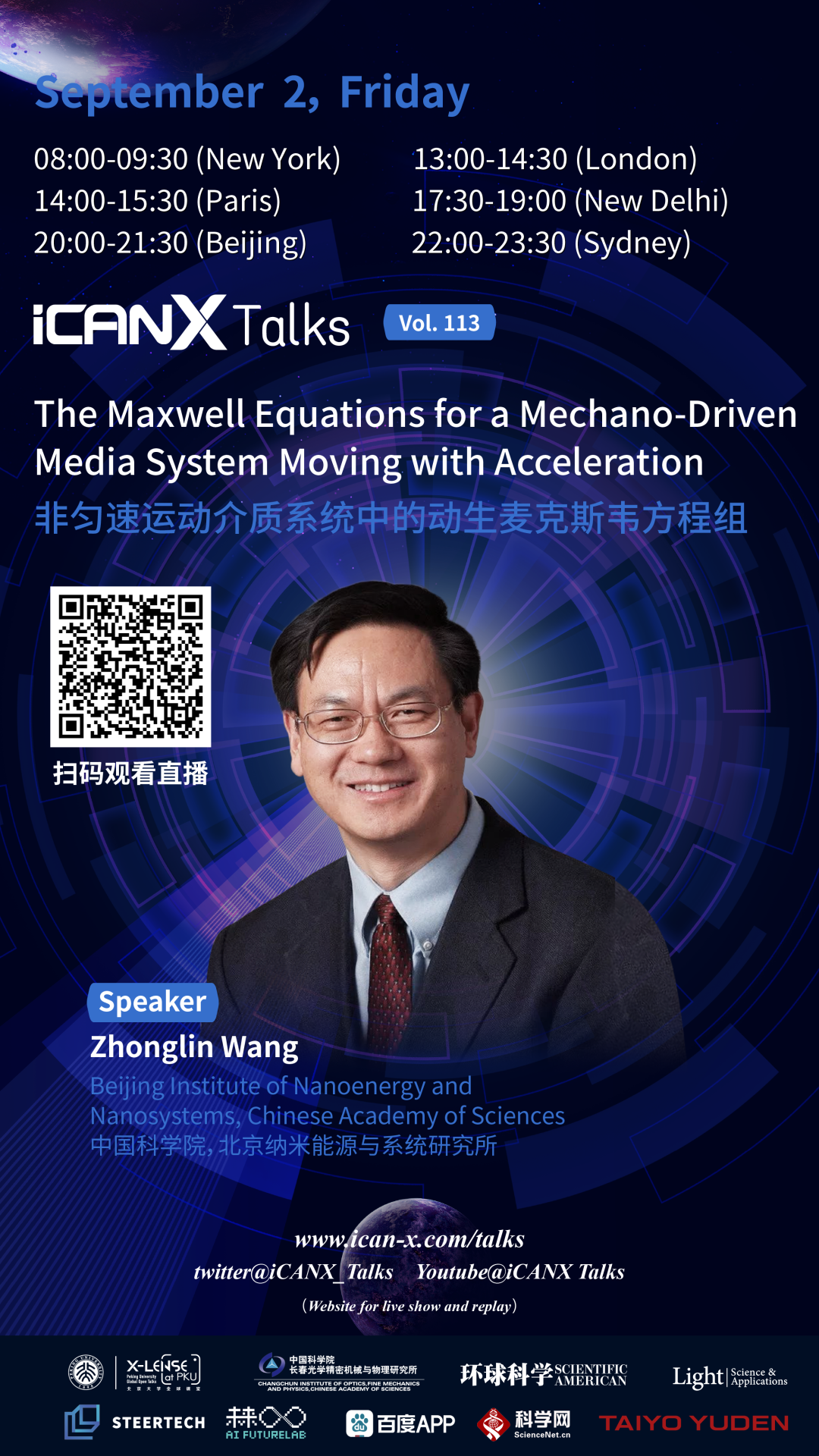博文
9月2日晚八点iCANX直播︱王中林:非匀速运动介质系统中的动生麦克斯韦方程组
||
本期为 iCANX Talks 第113期,北京时间9月2日(周五)20:00,中国科学院北京纳米能源与系统研究所的王中林院士的讲座将准时在 iCANX 平台开播!
他与大家分享的主题是“非匀速运动介质系统中的动生麦克斯韦方程组”,其团队推导出了低速运动介质中的动生麦克斯韦方程组,本次报告主要介绍方程组的推导,推导的假设和未来潜在的应用。
This is iCANX Talks Vol.113. At 20:00 on September 2 (Friday), Beijing time, the lecture by Academician Zhonglin Wang of Beijing Institute of Nanoenergy and Nanosystems, Chinese Academy of Sciences will be broadcast on the iCANX platform on time!
The topic is "the Maxwell Equations for a Mechano-Driven Media System Moving with Acceleration". In this talk, he will introduce the derivation of the Maxwell equations for mechano-driven slow- moving media., the assumptions of the derivation and potential future applications.
报告信息 主题:非匀速运动介质系统中的动生麦克斯韦方程组 Topic: the Maxwell Equations for a Mechano-Driven Media System Moving with Acceleration 主讲人:中国科学院,北京纳米能源与系统研究所 王中林 Speaker:Zhonglin Wang, Beijing Institute of Nanoenergy and Nanosystems, Chinese Academy of Sciences 时间:9月2日(周五)北京时间 20:00 Date: September 2 (Friday) 08:00 (New York) 13:00 (London) 14:00 (Paris) 17:30 (New delhi) 20:00 (Beijing) 22:00 (Sydney) 地点:iCANX Talks 平台 https://www.ican-x.com/talks 报告介绍/Abstract 我们2012年首次发明了摩擦纳米发电机(TENG),它的应用范畴涉及到多个领域,例如微纳能源,自驱动传感,医疗健康,环境保护与检测,穿戴式与柔性电子器件,安防技术等。摩擦纳米发电机的原理是基于介质相对运动而产生的位移电流而把机械功转为电功的。当运动的频率变高时,就有“动而产生的电磁辐射”,为了描述这些未来科学的发展,我们推导出了低速运动介质中的动生麦克斯韦方程组(Maxwell equations for mechano-driven slow-moving media。首次在电位移矢量D中增加了Ps项,其代表由于机械动而产生的表面电荷而引入的极化项,在麦克斯韦方程组中由原来的电磁转换引入了代表“动生电”的物理项及其力-电-磁耦合。正是由于这一项,我们才能推算出由于动而产生的电功输出和相应的电磁波辐射。延伸的麦克斯韦方程组基于两个条件:v << c;忽略由于介质运动而产生的相对论效应。因此新推导出的方程组适用于描述工程中有多个运动介质在实验室坐标系中所观测到的电磁现象。这种处理足以保证在实际技术应用中的准确性和精确性。而由于运动而辐射出的电磁场在空间的传播满足狭义相对论和麦克斯韦方程组。本报告主要介绍方程组的推导,推导的假设和未来潜在的应用。 We first invented the triboelectric nanogenerator (TENG) in 2012. Its application involves many fields, such as micro-nano energy, self-driven sensing, medical and health, environmental protection and detection, wearable and flexible electronic devices, security technology, etc. The principle of triboelectric nanogenerator is to convert mechanical work into electrical work based on the displacement current generated by the relative motion of the medium. When the frequency of motion becomes higher, there is "electromagnetic radiation generated by motion". In order to describe the development of these future sciences, we deduce the Maxwell equations for mechano-driven slow- moving media. For the first time, the Ps term is added to the electric displacement vector D, which represents the polarization term introduced by the surface charge generated by the mechanical movement, and the original electromagnetic transformation is introduced in Maxwell's equations to represent "moving electricity" the physical term of and its force-electricity-magnetic coupling. It is because of this term that we can deduce the electrical work output due to motion and the corresponding electromagnetic wave radiation. The extended Maxwell equations are based on two conditions: v << c; Ignore the relativistic effects due to the motion of the medium. Therefore, the newly derived equations are suitable for describing the electromagnetic phenomena observed in the laboratory coordinate system with multiple moving media in engineering. This processing is sufficient to ensure that in practical technology Accuracy and precision in application. And the propagation of electromagnetic fields radiated in space due to motion satisfies the special theory of relativity and Maxwell's equations. This report mainly introduces the derivation of the equations, the assumptions of the derivation and potential future applications. 主讲人介绍/Biography 王中林院士,中国科学院北京纳米能源与系统研究所所长,中国科学院大学讲席教授,纳米科学与技术学院院长、佐治亚理工学院终身校董事讲席教授。王教授是2019年爱因斯坦世界科学奖(Albert Einstein World Award of Science)、2018年能源界最高奖 - 埃尼奖 (ENI award – The “Nobel prize”for Energy)、2015年汤森路透引文桂冠奖、2014年美国物理学会James C. McGroddy新材料奖、和2011年美国材料学会奖章(MRS Medal)等国际大奖得主。他是中科院外籍院士、欧洲科学院院士、加拿大工程院外籍院士,国际纳米能源领域著名刊物 Nano Energy (最新IF:19.08)的创刊主编和现任主编。 王院士是纳米能源研究领域的奠基人。他发展了基于纳米能源的高熵能源与新时代能源体系;开创了基于纳米发电机的自驱动系统及蓝色能源宏大领域,与基于压电电子学与压电光电子学效应的第三代半导体的崭新领域;建立了压电电子学、压电光电子学与摩擦电子学学科;发现了六个新物理效应:压电电子学效应、压电光电子学效应、压电光子学效应、摩擦伏特效应、热释光电子效应和交流光伏效应。王教授有上百个美国和国际专利,并孵化了五家企业。 Academician Zhonglin Wang is Director of the Beijing Institute of Nano Energy and Systems, Chinese Academy of Sciences, Chair Professor of the University of Chinese Academy of Sciences, Dean of the School of Nanoscience and Technology, and Chair Professor of the Georgia Institute of Technology. Prof. Wang is the recipient of the 2019 Albert Einstein World Award of Science, the 2018 ENI award – The “Nobel prize” for Energy, the 2015 Thomson Reuters Citation Laureate Award, the 2014 American Physical Society James C. McGroddy Award for New Materials, and the 2011 American Materials Society Medal (MRS Medal) and other international awards. He is a foreign academician of the Chinese Academy of Sciences, an academician of the European Academy of Sciences, a foreign academician of the Canadian Academy of Engineering, and the founding and current editor-in-chief of Nano Energy (latest IF: 19.08), a well-known international journal in the field of nano-energy. Academician Wang is the founder of the field of nano-energy research. He has developed high-entropy energy based on nano-energy and a new-era energy system; created a self-driven system based on nano-generators and the grand field of blue energy, and the third-generation semiconductor based on piezoelectric and piezoelectric optoelectronic effects. The new field of piezoelectronics, piezoelectric optoelectronics and triboelectronics was established; six new physical effects were discovered: piezoelectric effect, piezoelectric optoelectronic effect, piezoelectric photonic effect, tribovolt effect , thermoluminescence photoelectron effect and AC photovoltaic effect. Professor Wang holds hundreds of US and international patents and has incubated five companies.

长按识别二维码,一键预约!
Long press to identify the QR code and jump to the webpage!
https://blog.sciencenet.cn/blog-299-1353670.html
上一篇:北京大学张海霞教授团队在多模态传感体系及多参量解耦合设计研究中取得重要进展
下一篇:iCANX国际科学家俱乐部正式开启!